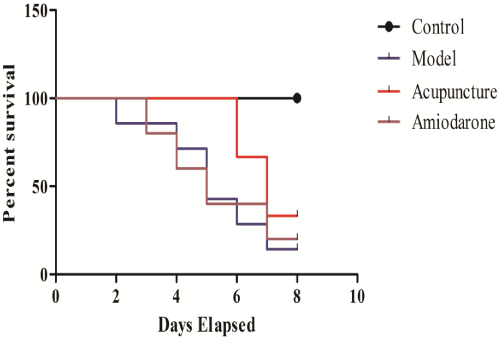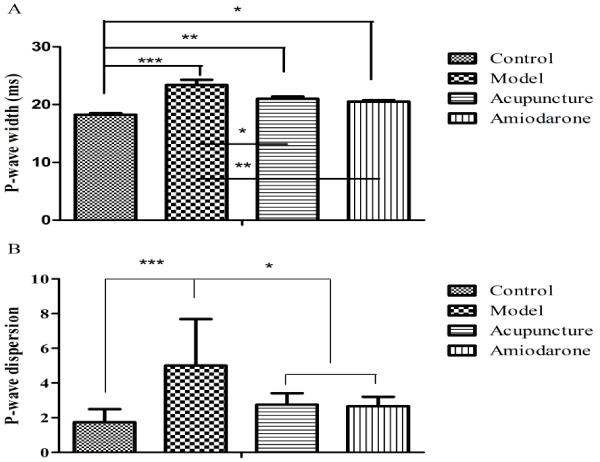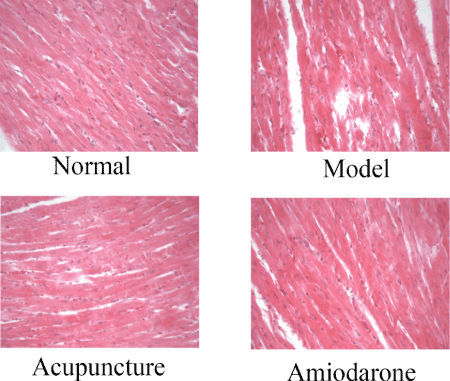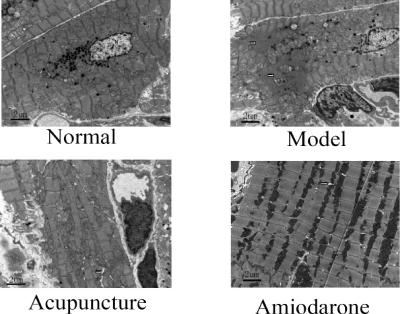Research Article Open Access
Acupuncture Prevents the Atrial Fibrillation through Improving Remodeling of Atrial Appendage in Rats
| Zhu P1, Zhang M1, Yang M1, Puji D2, Ying Guo1, Ao P3 and Sun Y1* | |
| 1The 2nd affiliated hospital of Heilongjiang TCM University, China | |
| 2TCM hospital of Daqing City, China | |
| 3The expriment center test cabinet of heilongjiang TCM University, China | |
| Corresponding Author : | Sun Y The 2nd affiliated hospital of Heilongjiang TCM University, China Tel: 008-6451-8709-3371 E-mail: 13069870666@163.com |
| Received December 22, 2015; Accepted January 02, 2016; Published January 04, 2016 | |
| Citation: Zhu P, Zhang M, Yang M, Puji D, Guo Y, et al. (2016) Acupuncture Prevents the Atrial Fibrillation through Improving Remodeling of Atrial Appendage in Rats. J Tradi Med Clin Natur 5:186. doi:10.4172/jtmcn.1000186 | |
| Copyright: © 2016 Zhu P, et al. This is an open-access article distributed under the terms of the Creative Commons Attribution License, which permits unrestricted use, distribution, and reproduction in any medium, provided the original author and source are credited. | |
| Related article at Pubmed, Scholar Google | |
Visit for more related articles at Journal of Traditional Medicine & Clinical Naturopathy
Abstract
The evidence from clinical experiments of acupuncture given at Neiguan (PC 6) spot has been proven effective in cardiovascular pathologies including cardiac arrhythmia. To understand how acupuncture prevents the atrial fibrillation (AF), the most common cardiac arrhythmia, an in vivo model of AF in rat was induced with continuous tail injection with CaCl2 and ACH for 7 days. Meanwhile, bilateral acupuncture at PC6 was treated for 30 min just before the injection, and amiodarone worked as a positive control in this study. We found that both acupuncture (PC 6) and amiodarone treatments could effectively prevent the onset of arrhythmia and restore the sinus rhythm in AF rats. The analysis of ECG showed the AF maximal durations (p<0.05) and P-wave dispersion (p<0.05) in acupuncture (PC 6) were reduced. H & E-stained sections of the right atrial appendage from model group showed interrupted cardiomyocytes, myolysis, interstitial edema and increased extracellular space, which could be significantly improved by acupuncture at PC 6 group. Ultrastructure changes also were observed with electron microscope. Compared with the rats from model group, the sarcomeres were organized normally, and the number of swollen mitochondrial was reduced in the group of acupuncture at PC 6. Moreover, there were no major ultrastructure differences with the amiodarone group. These results suggest that the anti-arrhythmia effect of acupuncture may be mediated through the restoration and modification of remodeling of right atrial appendage.
| Keywords |
| Acupuncture; Atrial fibrillation; Remodeling of atrial appendage |
| Introduction |
| Atrial fibrillation (AF) as the most common clinical cardiac dysrhythmia is a major cause of morbidity and mortality [1,2]. The number of patients with AF is constantly increasing as a result of aging, hypertension, cardiac infarction and congestive heart failure (CHF) [3,4]. Moreover, the lifetime risk of AF are high (1 in 6), even in the absence of CHF or cardiac infarction [5]. Patients with AF suffer a wide range of symptoms, such as palpitations, dyspnea, fatigue, dizziness, angina, and decompensated heart failure. In addition, Symptomatic AF can be combined with hemodynamic impairment, tachycardia-induced heart failure, and systemic thromboembolic events [6]. AF is emerging as a major public health concern and represents a major social and economic problem. |
| Cumulating evidences prove that AF is much more complicated than a simple electrophysiological disorder. The underlying mechanisms of AF susceptibility are not well characterized. Many triggers have the potential for initiation and maintenance of AF, which may therefore explain the difficulties in managing AF patients [4,7]. The present therapeutic strategies for atrial fibrillation generally are dependent on the antiarrhythmic and anticoagulant drugs in the sinus rhythm maintain, rate controlling and coagulation resisting [8]. There are many major limitations, including limited efficacy, risks of proarrhythmic events, a relatively high recurrence rate and hemorrhagic tendency [8,9]. These issues have inspired efforts to develop safer and more effective antiarrhythmic drugs and improved therapeutic approaches. More recent approaches for rate control, such as non-pharmacological ablation and atrioventricular node ablation, are improving, but safety and effectiveness are imperfect and remain uncertain. [10,11]. In China, acupuncture as one of tranditional treatment modalities is the most familiar to Western medicine [12]. Acupuncture given at Neiguan (PC 6) spot has been found effective for treatment of cardiovascular pathologies with regard to paroxysmal supraventricular tachycardia [13]. Recently, several clinical trials demonstrate the efficacy of acupuncture in antiarrhythmias and preventing arrhythmic recurrences after cardioversion in patients with persistent AF [14,15]. To date, unfortunately, the evidence of acupuncture in the treatment of arrhythmias has not been well accepted because of the limited methodologic quality of the clinical trials and the lack of diverse patient populations. |
| Given the limitation and controversial in those clinical datum [14,16,17], we utilized drug-induced AF Sprague Dawley (SD) rats model by acupuncture at Neiguan (PC 6) spot, supposed to have a calming and sedative effect on cardiac excitability in patients [18,19] to confirm the efficacy of acupuncture in AF. The right atrial was harvested to evaluate the right atrial remodeling, which is closely related with the onset of AF [7,20]. The aim of our study was therefore to evaluate the antiarrhythmic effects of acupunctural therapy and make patients benefit from this ancient medical modality. |
| Methods |
| Animals |
| Male Sprague├ó┬?┬?Dawley rats (initial body weights ~250 g) were provided by the Department of Experimental Animal Sciences Center, Heilongjiang University of Chinese Medicine. The animals were kept on a 12-h/12-h light/dark cycle in a temperature-controlled (22°C) room and were given standard rat chow and water ad libitum throughout the experiment. All animal procedures were strictly conducted in accordance with the international ethical guidelines and National Institutes of Health guide concerning the Care and Use of Laboratory Animals and were approved by the Animal Care and Use Committee of Heilongjiang University of Chinese Medicine. |
| Method for inducing AF and mortality |
| We followed the methods described by Tang et al. for induction of AF model [21]. SD rats were injected intraperitoneally with sodium pentobarbital (30 mg/kg) in a concentration of 10 mg/mL, followed by intravenous injection with CaCl2 (10 mg/mL) and ACH (acetylcholine, 66 μg/mL) through the tail vein once a day for 7 days. A typical AF electrocardiogram (disappearance of the P wave and the appearance of the f wave) appeared immediately and recovered to sinus rhythm (disappearance of the f wave and the appearance of the regular P wave) in the following tens of seconds. The electrocardiogram (ECG) recording was maintained from rat anesthetized to administration finishing, approximately 30 minutes each rat each day for 7 days. Some rats died during the period of the induction of AF. The death rates were reported for this period based on the number of dead rats and the total number of the rats allocated to the given group. |
| Acupuncture methods and grouping |
| As illustrated in Figure 1B, the acupoints “Nei-Guan” (PC6) is located 3 mm lateral and distal to the wrist joint and between the radius and ulna in the fore limb. For acupuncture stimulation, stainless steel needles (0.25 mm in diameter) were vertically inserted into the selected acupoints (PC6) and applied for 30 min before the intravenous administration of CaCl2 and ACH. Acupuncture treatment was given every day for 7 sessions in total. |
| A flowchart of the study protocol is shown in the schematic diagram in Figure 1A. Male rats were randomized into the following groups with 14 rats per group: Control group (injection of saline from day1 to day 7), Model group (injection of CaCl2 and ACh mixture from day1 to day 7), Acupuncture group (Acupuncture treatment at PC 6 once a day for 30 min once a day, followed with injection of CaCl2 and ACh mixture from day1 to day 7), Amiodarone group (oral treatment of 4.5 mg/kg Amiodarone once a day from day1 to day 7, followed with injection of CaCl2 and ACh mixture 30 min later). |
| Electrocardiogram |
| ECG (lead II) recordings were performed to quantify ECG parameters (Heart rate, AF duration, P-wave width and P-wave dispersion). As shown in Figure 1C, Electrodes were placed under the skin for recording the conventional bipolar limb leads (II). In order to avoid errors in the position of the leads, the electrodes were always placed by the same person. The ECG was recorded using a threechannel digital ECG recorder with a paper speed of 50 mm/s and sensitivity of 0.5 mV/cm. |
| Histology |
| For Hematoxylin and eosin (H & E) staining, dissected right atrial appendages were immediately fixed with 10% formalin overnight at room temperature, dehydrated in an ethanol series, and paraffin embedded. Coronally sectioned tissues (5 μm) were deparaffinized in in a xylene-ethanol series and also dehydrated in an ethanol-xylene series. The sections were used to stain with hematoxylin/eosin (HE). Following washes in deionized water, dehydrated via ethanol, cleared in Xylene and slides were mounted. Each slide was examined by light microscopy. |
| Ultrastructure analysis |
| Right atrial appendages were fixed in cold 2,5-glutaraldehyde in 0.1 mol/L cacodylate buffer (pH 7.3), postfixed in 1%OsO4, dehydrated, and embedded in Epon. Thick sections (about 1 μm) were stained with toluidine blue and observed by light microscopy in order to select fields. Ultrathin sections were mounted on copper grids, stained with uranyl acetate and lead citrate, and examined under an electron microscope (4200 ×). |
| Statistical analysis |
| Normal data were expressed as mean±SD, whereas non-normal data were expressed as medians (interquartile range). Analysis of variance (ANOVA) and pairwise comparisons were used for normal data. Yates’ chi-square test (χ 2) was used for intergroup comparisons of mortality rates. |
| Results |
| Acupuncture at P6 showed no significant difference in survival data |
| Data from 56 SD rats were analyzed in this study (14 in each of the 4 groups). Survival after induction of AF differed among the four groups Figure 1D. In the model group, 6 rats died in model group within the first 7 days; 0, 4 and 3 rats died in the control, amiodarone and acupuncture group, respectively. The mortality rates on 7 d showed no marked difference among the four experimental groups (p├»┬╝┬?0.05). |
| Effects of acupuncture on arrhythmic rats induced with AF |
| When the induction of AF was stable in the model group on the 7th day, the ECG data was selected for further analysis on the AF duration, P-wave width, and heart rate. Figure 1C shows the representative tracings of ECG recorded from the AF rat. The P wave was disappeared, the f wave was appeared and the duration of the R-R interval was prolonged, suggesting that a stable paroxysmal AF could be induced by intravenous injection of CaCl2 and ACh. Figures 2 and 3 is the statistical graphics among the groups. Compared with model group, both acupuncture and amiodarone could reduce the AF durations (p<0.05, n=8) and P-wave dispersion (p<0.05, n=8) by approximately 50%, except for P-wave width, within 30 min after the injection of CaCl2 and ACh. |
| Acupuncture improved morphological changes in right atrial appendage of AF rat |
| As shown in H&E-stained sections of the right atrial appendage, the injection of CaCl2 and ACh resulted in pronounced morphological responses. The characteristics were focal interrupted cardiomyocytes, myolysis, interstitial edema and increased extracellular space, which also could be observed in patients with chronic AF [22]. Compared with model group, the treatment of acupuncture or amiodarone could improve these morphologic changes. |
| Effects of acupuncture on the ultrastructure of right atrial appendage of AF rat |
| The right atrial cardiomyocytes in control group showed a tightly organized sarcomeric structure and Z-lines were clearly visible at higher magnification (arrows). As expected on basis of light microscopic observations, ultrastructure changes could be observed in the right atrial cardiomyocytes of AF model controls at day 7 (Figures 4 and 5). A significantly higher number of cardiomyocytes with disassembled sarcomeres, and an increased number of swollen mitochondria with fusion of mitochondrial were identified. The intercalated discs also appeared to be interrupted. In the Acupuncture groups, the sarcomeres were organized normally and although some lightly swollen mitochondrial was observed, there were no major signs of ultrastructure compared with the amiodarone controls. |
| Discussion |
| As an important alternative therapy in China, acupuncture may be used to treat a variety of cardiovascular dysfunctions including reduction of arrhythmic events and recurrence [23]. However, the various antiarrhythmic effects of acupuncture were not based on formal clinical trials conducted in a rigorous scientific manner, and the weaknesses of standardized regimen and mechanic study have been considered the shortness in the field of evidence-base medicine [24,25]. In the present study, we established an in vivo AF model in rats and evaluated the Antiarrhythmic effects of repeated acupuncture stimulation at Neiguan point (P6). Our data suggested that the antiarrhythmic effects of acupuncture appeared to be similar to that of the amiodarone, inducing the restoration of morphometric and ultrastructural changes. |
| The development of numerous animal models of AF with clinically relevant disease paradigms has been a major advance over the last decades, which provided the practitioners a new insight to change the skepticism that acupuncture was based heavily on clinical subjective judgment, and lack of rigorous experimental evidence. With the going deep of the anti-arrhythmic mechanism of acupuncture, a plausible hypothesis on its antiarrhythmic effect could be through an action on the autonomic nervous system. Indeed, an increase in vagal or sympathetic neural activity directed to the heart might favor the initiation and maintenance of AF episodes in patients, and vagal nerve stimulation or acetylcholine infusion often was used to sustain AF in animals [26,27]. In this case, we utilized an infusion with acetylcholine and CaCl2 to induce the AF in animal with normal heart [21], which could be applicable to the impact of acupuncture on improving cardiac arrhythmias. |
| The Neiguan spot is located in the portion of the Meridian of the Heart Minister situated in the forearm, along the course between the two tendons, which controls blood-flow as well as pulse rate in traditional Chinese medicine. In the early studies, Neiguan spot, as the point most commonly used for treating cardiac disorders, has been well known and proven effective in patients with symptomatic coronary artery disease [28-30], and the results have also been confirmed in experimental myocardial infarcted animals by stimulating the Neiguan point [31-33]. Whether the acupuncture on the Neiguan spot could be an effective non-invasive and safe antiarrhythmic tool in patients [34], further studies with rigorous controlled experiments should be made. The main finding of this study was that Naiguan acupuncture continued for 0.5 h was as effective as amiodarone in reducing duration of symptomatic AF episodes and P-wave dispersion by approximately 50%, without the suppression of heart rates compared with amiodarone treatment in conscious rats. More pertinent to our results was the experimental evidence that acupuncture of the Neiguan spot exerted an antiarrhythmic effect similar to that of amiodarone in patients with persistent AF [34], and Neiguan stimulation could augment sympathetic tone and improve the inhibited cardiovascular function under anesthetic dogs [35]. Moreover, Acupuncture pretreatment also exerted a modulatory function on the autonomic nervous system by regulating the firing rate of the amygdala nucleus [36], and attenuated the increase of [Ca2+]i in the myocytes isolated from the rat hearts subjected to ischemia-reperfusion by regulating L-type Ca2+ channel [25]. We could speculate anti-arrhythmic effects of acupuncture would primarily be due to the sympathetic tone activated, counterbalancing a reduction of action potential duration (APD) and reentry circuits [27]. |
| In addition to electrophysiological dysfunctions, recent studies indicated that cardiomyocytes underwent dramatic structural alterations during AF, in which calcium overload and stretch appeared to be important regulating mechanisms [20,22]. In our in vivo rat model of AF, the structural remodeling, such as myolysis, focal interrupted cardiomyocytes and edema was also observed in AF rats induced with. However, the fibrosis was not obvious in our procedure. We speculated that short-term irritation with ACh and calcium could not induce the chronic structural remodeling. The electron microscope analysis of ultrastructure showed changes that were comparable to those histological changes seen in H&E staining heart of AF rats. Myolysis was illustrated accompanied with the presence of disassembled sarcomeres. Within the myolytic areas, the mitochondria displayed remarkable swollen, but their cristae appeared normal. The present results showed that acupuncture pretreatment restored the morphological and ultrastructural changes to some extent, even though the improvements of amiodarone pretreatment looked better. Given that interconnection between the structural remodeling and recurrence of AF [37,38]. We could speculate that acupuncture repeatedly over a period of days not only restored sinus rhythm but also reduced the recurrence rate of AF. |
| Our study was not designed to elucidate further details of antiarrhythmic effects of acupuncture in cellular and subcellular levels, but we provided experimental evidence for participants willing to try this traditional non-pharmacologic therapy. Considering that acupuncture was safe, effective, without any pro-arrhythmic effect compared with the classical pharmacological therapy, this traditional Chinese medicine had a potential to become a more mainstream complementary intervention in the treatment of atrial fibrillation. |
References
|
Figures at a glance
 |
 |
 |
 |
 |
| Figure 1 | Figure 2 | Figure 3 | Figure 4 | Figure 5 |
Relevant Topics
- Acupuncture Therapy
- Advances in Naturopathic Treatment
- African Traditional Medicine
- Australian Traditional Medicine
- Chinese Acupuncture
- Chinese Medicine
- Clinical Naturopathic Medicine
- Clinical Naturopathy
- Herbal Medicines
- Holistic Cancer Treatment
- Holistic health
- Holistic Nutrition
- Homeopathic Medicine
- Homeopathic Remedies
- Japanese Traditional Medicine
- Korean Traditional Medicine
- Natural Remedies
- Naturopathic Medicine
- Naturopathic Practioner Communications
- Naturopathy
- Naturopathy Clinic Management
- Traditional Asian Medicine
- Traditional medicine
- Traditional Plant Medicine
- UK naturopathy
Recommended Journals
Article Tools
Article Usage
- Total views: 12161
- [From(publication date):
January-2016 - Apr 04, 2025] - Breakdown by view type
- HTML page views : 11214
- PDF downloads : 947
